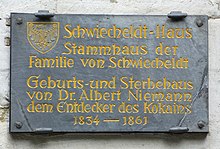Albert Niemann (chemist)
Albert Niemann | |
|---|---|
| Born | May 20, 1834 Über eine neue organische Base in den Cocablättern (1860) |
| Doctoral advisor | Friedrich Wöhler |
Albert Friedrich Emil Niemann (May 20, 1834 – January 19, 1861) was a German chemist. In 1859 - about the same time as Paolo Mantegazza - he isolated cocaine, and he published his finding in 1860.[1]
Life
Niemann was born in Goslar, then in the Kingdom of Hanover, the son of a school principal. In 1849 he began an apprenticeship at the town hall pharmacy in Göttingen, where, starting in 1852, he was a Ph.D. student at the George August University.[1]
Cocaine

In the 19th century, there was great interest among European chemists in the effects of coca leaves discovered in Latin America. In 1855 the chemist Friedrich Gaedcke had published a treatise on an active alkaloid extract of the coca leaf he called erythroxyline, after the genus Erythroxylum, from which cocaine-rich leaves are obtained. This extract was benzoylmethylecgonine, or cocaine, though it lacked in purity. He published a description in the journal Archiv der Pharmazie.[2]
Mustard gas
During experiments with ethylene and sulfur dichloride in 1860, Niemann produced mustard gas. He was among the first to document its toxic effects,[5] but he might have not been the first to synthesize it.[6] In 1860 and almost in parallel to Niemann, Frederick Guthrie reported the same reaction as Niemann.[5] Guthrie also noted the toxic properties of mustard gas at that time.[6]
In 1860, Niemann described the properties of mustard gas as: Sie besteht darin, daß selbst die geringste Spur, die zufallig auf irgend eine Stelle der Haut kommt, anfangs zwar keinen Schrnerz hervorruft, nach Verlauf einiger Stunden aber eine Rötung derselben bewirkt und bis zum folgenden Tage eine Brandblase hervorbringt, die sehr lange eitert und außerordentlich schwer heilt , unter Hinterlassung starker Narben. (They are represented by the fact that, even traces brought into contact with the skin, while painless at first, result in a reddening of the skin after several hours, and in the following days produce blisters which fester and heal slowly and with great difficulty, leaving behind significant scarring.)[7]

Death
Niemann died on 19 January 1861 in his hometown Goslar, reportedly of "suppuration of the lung".[citation needed] Niemann worked with mustard gas since 1860 and exposure to it probably resulted in his death.[5] After his death, his colleague Wilhelm Lossen continued his investigations, and identified the chemical formula of cocaine in 1862.[1]
References
- ^ ISBN 0415192471.
- S2CID 86030231.
- ISBN 0-8493-0343-5.
- ^ S2CID 98195820.
- ^ S2CID 39526725.
- ^ ISBN 030904832X.
- .
